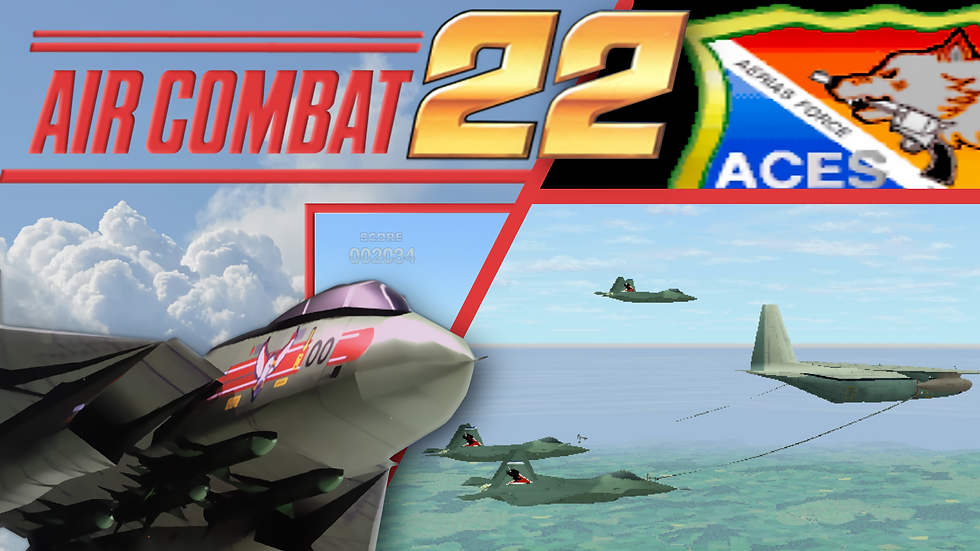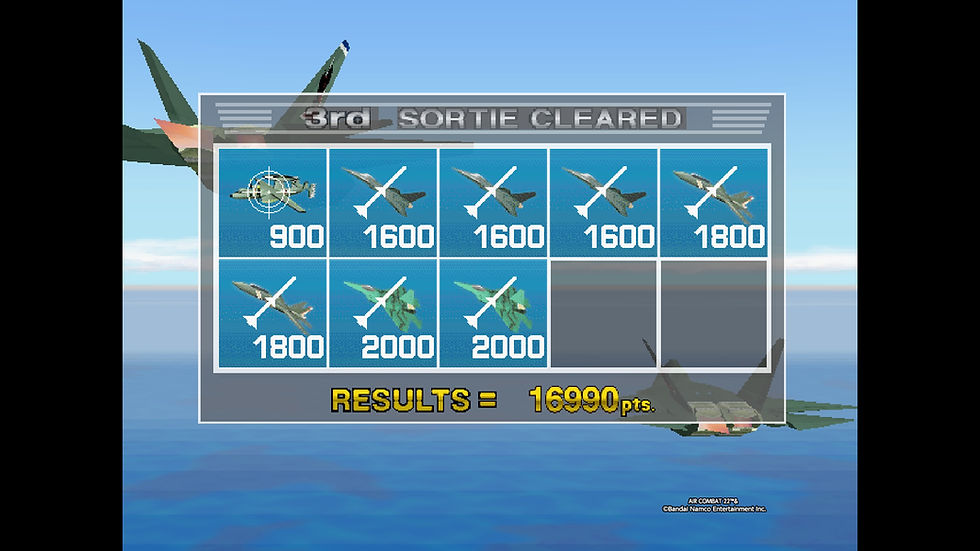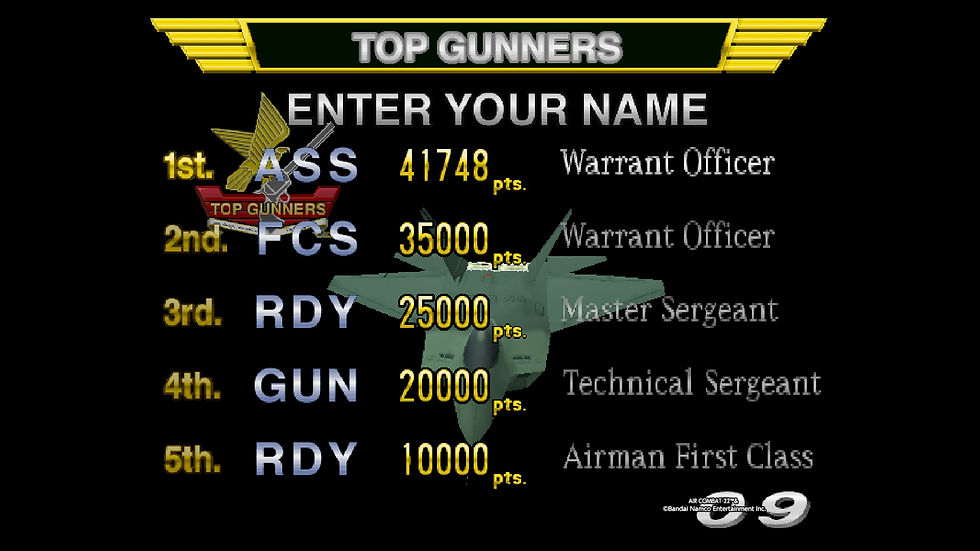Arcade Archives Air Combat 22: A Deeper Dive
- T.J. "Millie" Archer

- Jul 23
- 6 min read
It took thirty years, a quarter-billion dollars, and 275,000 combined man-hours of development, but we finally have successfully ported Air Combat 22 to console.

I’ve never actually had a chance to play this game until now. Arcade emulation is actually a harder task than many would believe, and though Namco System 22 emulators are readily available, it’s not something I’ve ever bothered to get into due to difficult experiences in the past with attempts at Sega AM2 and NAOMI emulator installs. I’ve of course been aware of Air Combat 22 as the “first” Ace Combat; it’s the reason the North American release of Ace Combat for the PS1 was changed to “Air Combat”, to better connect consumers with the arcade roots and attach a familiar name. Arcade ports and derived titles were very much still in vogue with the early 90s arcade resurgence, and it was probably a more educated move than we give it credit for.

But here it is in PS5 glory, thanks to the efforts of Hamster Coporation’s Arcade Archives series and Bandai Namco. I don’t recall ever seeing this machine or the original Air Combat in any arcades that I visited in the past. Odd considering it had extraordinary appeal for several years, with arcade-centric magazine publishers noting its high demand several years after its first release and noting its ubiquity in arcades around the United States. Had I seen it though, I think it would have left as strong an impression on me as any of the Sega machines I gush over.
Air Combat 22 immediately assaults your senses in only a way a 90s arcade game can, with brickwalled voiceover lines crushed by a soundtrack that overpowers each syllable. The game only gives you about 10 seconds to choose your flight mode, screaming at you to scramble the whole time. Suffice to say, I was stressed as hell and loving every moment so far.
Immediately, I’m going to say that if you “get” Ace Combat, don’t bother with choosing the Cadet with Tutorial option. It hits you at the most inopportune times with hints, and it’s activates the same part of my brain that fires anytime a YouTube video is interrupted by an ad.

So, I rebooted and jumped into normal “Cadet” difficulty. The first thing I’ll say is that we as a community should probably stop making fun of those who play Ace Combat using novice controls. It’s literally the original and only scheme that you can use for this game. Therefore, we can only conclude that those that play with novice controls are the true franchise purists. These controls though… the SNAP. The aircraft in this game turn like a bat out of hell. We’re talking like 500G’s. I’m not sure if this is a translation approximation for what would be the original flight stick porting to the far smaller lever of a console controller analog stick, but you have to learn to be gentle with the controls.

But the DNA is there. Every last bit of it. This is literally what we now know as Ace Combat in its most distilled form. I found myself instinctively releasing two missiles anytime I had a successful lock, which quickly and unnessacarily depleted my reserves. It’s one missile kills against all targets in this game, and you’ll quickly pick it up. Gun kills are a challenge. Despite the anachronistic dual guns with huge tracers equipped on either the F-14, YF-22, or Su-27M, you’ll struggle to land hits on anything that isn’t a lumbering transport.
What caught me off guard is how a few things that came into play later in the series like aerial refueling and chaff/flare actually can trace its roots all the way back to this game. In some ways its surprising that it took so many iterations to make their return. There are even echoes of gameplay that harmonize with Ace Combat Assault Horizon of all things, with the final assault on the carrier in the late game reminding me of the opening stages of “Naval Warfare”. And of course it would be remiss not to point out that this game’s direct sequel in form, function, and gameplay is Ace Combat 5’s Operation: Katina. All the way down to the way the Sortie Cleared screens match the camera angles shot for shot between stages. In fact, the similarities strengthen if you do a good job clearing the Top Gun difficult level… But you have to find that one out for yourself.

Another element that surprises me every time I revisit older arcade games like this is the graphical and sound fidelity. Backgrounds and terrain aside, the aircraft models are actually quite solid. The desire for arcade-accurate ports was still strong for consoles during this time, and when you look at the shading, control surface movement, and framerates you can see why that was such a gold standard. Arguably, Ace Combat didn’t get this kind of fidelity until after Ace Combat 3—the PS1 was never going to be able to provide this experience. The soundtrack is also solid and high energy, and the retrospective of being treated to The Sky Is Burning Out lights a fire under your toes to keep moving through the stages.
But I couldn’t help this nagging feeling of value in the back of my mind. When it comes down to the wire, this is an old arcade game. It’s entire existence as an arcade was to be a profit center, keeping the difficulty and engagement high enough to ensure that players would return with more tokens. In the latter, I would argue it still succeeds; I ran through each difficulty at least once and enjoyed myself each time. In the former though… Not so much. Perhaps its my thousands of hours playing Ace Combat over the past 25 years, or maybe it’s my familiarity with the eccentrics of 90s arcade gameplay mixed with the convenience of modern day control, but I managed to clear all four difficulties with a total of less than 10 credits. I ran the numbers in my head and was wondering what that would actually add up to in quarters burned. And that’s because this game is what I feel is an astounding $16.99 on the Playstation Store.

Even if I was being generous and assuming two dollars a play, this game barely scratches the value that I felt I received. It begs the question of why such an old game is so expensive. I’ll grant inflation is making gaming feel less and less affordable, but to be fair there’s also been a lot of improvements over the years and game development time isn’t as straightforward as it once was—there can be a justification made for the cost. But despite my joking anecdote as I opened this article, Air Combat 22 has made its money, and a couple of good programmers should have been able to port this successfully with modest effort.
I have a pet theory that the reason actually has to do with aircraft licensing costs; something that wasn’t so much a consideration in the past as it is today, but I may be hard-pressed to prove it. But does that justify what we get out of it? As a connoisseur of yesteryear’s entertainment and a nostalgia junkie, I’ll be willing to grant Ace Combat 22 the value modifiers that pushes it over that edge for me, but I can already say I’ve spoken to advanced Ace Combat players that balk at the price and aren’t willing to entertain the purchase. I find it difficult to fault that decision.

And that’s the kicker, isn’t it? Knock it down to 10 bucks, I’d be recommending this title in a heartbeat simply as a tour of the roots of a forest that we take for granted now. It certainly beats the pants off of Afterburner; I can see why Sega had to take some hard turns in the middle of the decade to respond to this game. But when I keep returning to the idea that I managed to beat the entirety of the game with less than 10 bucks and change… I don’t think I’ve ever quite seen such an occasion that an arcade port sides against the player’s hard-earned dollar compared to the arcade itself, especially when you consider the lack of fidelity, tactility, and immersion even a cheap cabinet can provide.
I want you to buy this game to support what I know is still the hard work and dedication of developers over at Hamster and Namco. And it’s still a fun experience from start to finish, but at only about five minutes a playthrough and a questionably high cost, there is too much stiff competition even in the retro space to capture more than a historical curiosity or a niche enjoyment from the experience of our carrier-launched YF-22.
Connect with 'Arcade Archives Air Combat 22'
About the Writer

A Life-long realist and aviation enthusiast. Once the co-founding Administrator of the Electrosphere.info English Ace Combat Database. In the present day he is freelance, roving the internet in search of the latest aviation news and entertainment. Read Staff Profile.




























































.png)